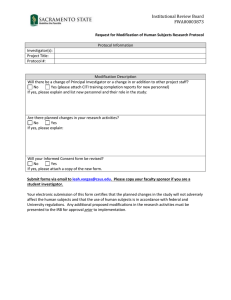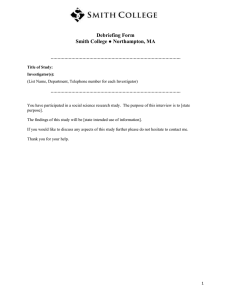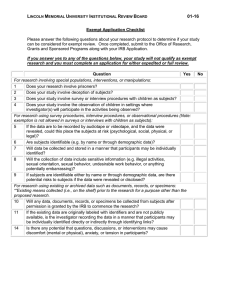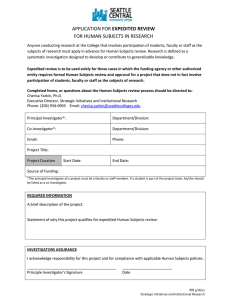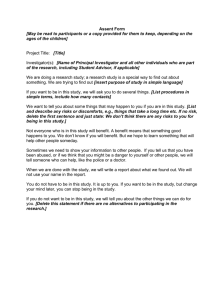Proposal Transmittal Form
advertisement
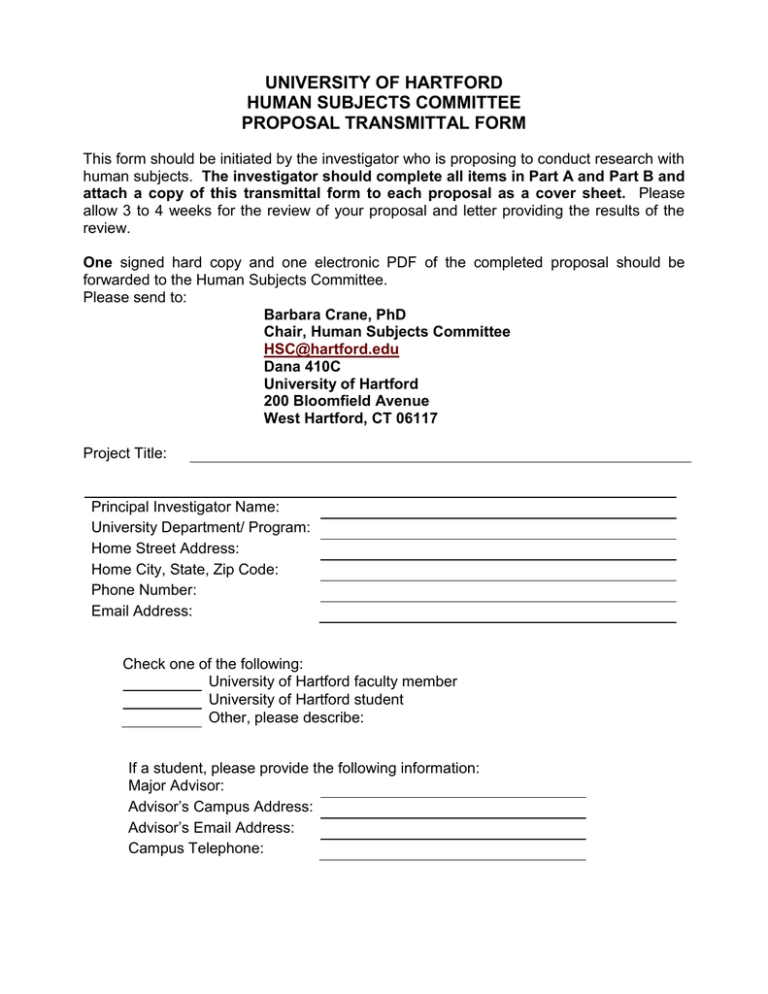
UNIVERSITY OF HARTFORD HUMAN SUBJECTS COMMITTEE PROPOSAL TRANSMITTAL FORM This form should be initiated by the investigator who is proposing to conduct research with human subjects. The investigator should complete all items in Part A and Part B and attach a copy of this transmittal form to each proposal as a cover sheet. Please allow 3 to 4 weeks for the review of your proposal and letter providing the results of the review. One signed hard copy and one electronic PDF of the completed proposal should be forwarded to the Human Subjects Committee. Please send to: Barbara Crane, PhD Chair, Human Subjects Committee HSC@hartford.edu Dana 410C University of Hartford 200 Bloomfield Avenue West Hartford, CT 06117 Project Title: Principal Investigator Name: University Department/ Program: Home Street Address: Home City, State, Zip Code: Phone Number: Email Address: Check one of the following: University of Hartford faculty member University of Hartford student Other, please describe: If a student, please provide the following information: Major Advisor: Advisor’s Campus Address: Advisor’s Email Address: Campus Telephone: For Human Subjects Committee use only 1. Date received from Principal Investigator: ___________________ 2. Routed for review to: ___________________________ Date: __________ To be completed by the Human Subjects Committee reviewer: 1. This proposal: _______ Qualifies for exempt status. It meets the conditions set forth in federal regulation 45 CFR 46.101(b). It is exempt from the regulations governing human subject research. _______ Qualifies for an expedited review as identified in federal regulation 45 CFR 46.110(b). _______ Requires full Human Subjects Committee review, for the following reasons: 2. This proposal: _______ is approved with no modifications or additional information required. _______ is approved following completion of minor modifications as described on the reviewer feedback form. _______ is not approved, and requires the following modifications and/or additional information, as described on the reviewer feedback form. 3. Signature of HSC Reviewer: _________________________ Date: _________ 4. Date returned to Human Subjects Committee Chair: __________________ 2 PART A (to be completed by the Principal Investigator): Proposals that have not been approved by a dissertation committee may not be submitted to the Human Subjects Committee. Has this research proposal been approved by the appropriate thesis or dissertation committee? Yes ______ No ______ 1. If your research involves the use of human subjects or data governed by other institutions, attach evidence of approval granted to you by the Institutional Review Board or Human Subjects Committee of those institutions, which permits your use of the subjects or data. 2. If your research involves the use of human subjects or data governed by other institutions, which do not have an IRB or HSC, attach evidence of approval granted to you by those institutions, which permits your use of the subjects or data. 3. Does your research involve subjects younger than 18 years of age, prisoners, pregnant women, mentally disabled persons, or economically/educationally disadvantaged persons? Yes _____ No ______ (If yes, Full Committee Review is required) To be completed by Principal Investigator: I attest that all information stated in the Proposal Transmittal Form is true. Signature of Principal Investigator: Date To be completed by Research Advisor (if applicable): I attest that I have reviewed this proposal and approve the content. To the best of my knowledge, the content is accurate, the study is methodologically sound, and the proposal conforms with all ethical requirements for human subjects research. Signature of Research Advisor: Date 3 PRINCIPAL INVESTIGATOR CHECKLIST: PLEASE CONFIRM THAT YOUR PROPOSAL INCLUDES ALL OF THE FOLLOWING ITEMS BY CHECKING IN THE APPROPRIATE COLUMN Summarize your research methodology using the sections indicated below (a – j). Do not attach your grant, dissertation, or thesis proposal. YES N/A Explain a. Project description - including a description of the study population and study purpose and a brief summary of the relevant background that supports the need for and procedures of the proposed research. Not to exceed 3 pages. b. Brief description of activities involving human subjects or human data (include subject selection procedures, sequence of procedures, numbers of subjects and time commitment expectations). Not to exceed 3 pages. c. Provide a brief description of procedures related to subject confidentiality or anonymity. Indicate how data will be stored and for how long. d. Samples of all informed consent and/or subject assent documents (see specific details for informed consent requirements below). e. Provide an assessment of human subject risk for: 1) physical injury; and 2) psychological injury f. Describe any direct benefit to be gained by the subject. g. Provide a brief description of any debriefing procedures (as appropriate). h. Attach a copy of all measures (e.g., questionnaires, scales, interview schedules, or focus group questions) i. Provide copy of all recruitment materials (i.e., letter of invitation, ads, flyers, emails, phone script). Include appropriate permissions for recruitment of subjects or placement of flyers (particularly if placing flyers on campus). j. Attach proof of Human Subjects Training (CITI) for principal investigator(s) and all research personnel Please include all of the following in your informed consent forms (d): Description of the basic purpose of the research to the subject. Description of the expected duration of participation. Description of benefits, or the lack of benefit, for participation (e.g. experimental credits). Description of experimental procedures to be followed. Description of foreseeable risks or discomforts (or lack of any known risks). A statement that participation is voluntary and that withdrawal will involve no penalty or loss of benefits to which subject is otherwise entitled. A statement describing the extent and procedures by which confidentiality of information will be maintained. Including how long data will be stored. Information that would allow the subject to contact the primary researcher and his/her advisor. Text written at a readable level for the subject population. (Microsoft word processing software can provide an assessment of the reading level of the text) The following two sentences: “If you have questions about your rights as a research subject, please contact the University of Hartford Human Subjects Committee (HSC) at 860-768-5371 or hsc@hartford.edu. The HSC is a group of people that reviews research studies and protects the rights of people involved in research.” 4 PART B (to be completed by the Principal Investigator) ALL PROPOSALS THAT CONCERN RESEARCH CONDUCTED WITH HUMAN SUBJECTS MUST BE SUBMITTED TO THE HUMAN SUBJECTS COMMITTEE FOR REVIEW. Indicate the type of HSC review you are requesting (see relevant descriptions below): ___ Expedited Review ___ Exempt Review ___ Full Committee Review Expedited review: For proposals to be considered for expedited review, research activities must present no more than minimal risk to human subjects and involve only procedures listed in one or more of the following categories (The activities should not be deemed to be of minimal risk simply because they are included on this list): 1) Clinical studies of drugs and medical devices only when condition (a) or (b) is met: a) Research on drugs for which an investigational new drug application is not required or b) Research on medical devices for which (i) an investigational device exemption application is not required; or (ii) the medical device is cleared/approved for marketing and the medical device is being used in accordance with its cleared/approved labeling; 2) Collection of blood samples by finger stick, heel stick, ear stick, or venipuncture as follows: a) from healthy, non-pregnant adults who weigh at least 110 pounds or b) from other adults and children, considering the age, weight, and health of the subjects, the collection procedure, the amount of blood to be collected, and the frequency with which it will be collected. 3) Prospective collection of biological specimens for research purposes by noninvasive means, such as: a) hair and nail clippings in a non-disfiguring manner; b) deciduous teeth at time of exfoliation or if routine patient care indicates a need for extraction; c) permanent teeth if routine patient care indicates a need for extraction; d) excreta and external secretions (including sweat); e) un-cannulated saliva collected either in an unstimulated fashion or stimulated by chewing gum base or wax or by applying a dilute citric solution to the tongue; f) placenta removed at delivery; g) amniotic fluid obtained at the time of rupture of the membrane prior to or during labor; h) supra- and subgingival dental plaque and calculus, provided the collection procedure is not more invasive than routine prophylactic scaling of the teeth and the process is accomplished in accordance with accepted prophylactic techniques; (i) mucosal and skin cells collected by buccal scraping or swab, skin swab, or mouth washings; (j) sputum collected after saline mist nebulization; 4) Collection of data through noninvasive procedures (not involving general anesthesia or sedation) routinely employed in clinical practice, excluding procedures involving x-rays or microwaves; 5) Research involving materials (data, documents, records, or specimens) that have been collected, or will be collected solely for non-research purposes (such as medical treatment or diagnosis); 6) Collection of data from voice, video, digital, or image recordings made for research purposes; 7) Research on individual or group characteristics or behavior or research employing survey, interview, oral history, focus group, program evaluation, human factors evaluation, or quality assurance methodologies; 8) Continuing review of research previously approved by the HSC as follows:(a) where (i) the research is permanently closed to the enrollment of new subjects; (ii) all subjects have completed all researchrelated interventions; and (iii) the research remains active only for long-term follow-up of subjects; or (b) where no subjects have been enrolled and no additional risks have been identified; or (c) where the remaining research activities are limited to data analysis; 9) Continuing review of research, not conducted under an investigational new drug application or investigational device exemption where categories two (2) through eight (8) do not apply but the IRB has determined and documented at a convened meeting that the research involves no greater than minimal risk and no additional risks have been identified. 5 Exempt Review: For proposals found to be exempt from federal regulations for full Committee review, (Proposals are not exempt from submission to the Human Subjects Committee) research activities will involve human subjects in one or more of the following: (1) Research conducted in established or commonly accepted educational settings, involving normal educational practices, such as (i) research on regular and special education instructional strategies, or (ii) research on the effectiveness of or the comparison among instructional techniques, curricula, or classroom management methods; (2) Research involving the use of educational tests (cognitive, diagnostic, aptitude, achievement), survey procedures, interview procedures or observation of public behavior, unless:(i) information obtained is recorded in such a manner that human subjects can be identified, directly or through identifiers linked to the subjects; and (ii) any disclosure of the human subjects' responses outside the research could reasonably place the subjects at risk of criminal or civil liability or be damaging to the subjects' financial standing, employability, or reputation; (3) Research involving the use of educational tests (cognitive, diagnostic, aptitude, achievement), survey procedures, interview procedures, or observation of public behavior that is not exempt under (2) of this section, if: (i) the human subjects are elected or appointed public officials or candidates for public office; or (ii) federal statute(s) require(s) without exception that the confidentiality of the personally identifiable information will be maintained throughout the research and thereafter; (4) Research involving the collection or study of existing data, documents, records, pathological specimens, or diagnostic specimens, if these sources are publicly available or if the information is recorded by the investigator in such a manner that subjects cannot be identified, directly or through identifiers linked to the subjects; (5) Research and demonstration projects which are conducted by or subject to the approval of department or agency heads, and which are designed to study, evaluate, or otherwise examine: (i) Public benefit or service programs; (ii) procedures for obtaining benefits or services under those programs; (iii) possible changes in or alternatives to those programs or procedures; or (iv) possible changes in methods or levels of payment for benefits or services under those programs; (6) Taste and food quality evaluation and consumer acceptance studies, (i) if wholesome foods without additives are consumed or (ii) if a food is consumed that contains a food ingredient at or below the level and for a use found to be safe, or agricultural chemical or environmental contaminant at or below the level found to be safe, by the Food and Drug Administration or approved by the Environmental Protection Agency or the Food Safety and Inspection Service of the U.S. Department of Agriculture. Full Committee Review: All cases where a proposal fails to qualify for either expedited or exempt category. All studies involving children or higher risk populations. 6
